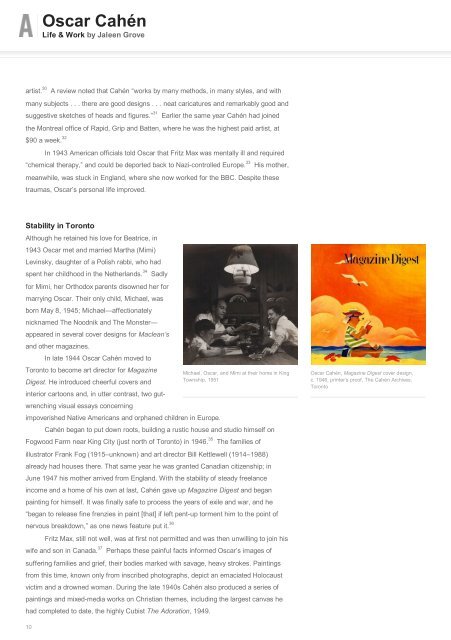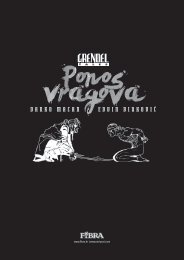Oscar Cahén
Art-Canada-Institute_Oscar-Cah%C3%A9n
Art-Canada-Institute_Oscar-Cah%C3%A9n
You also want an ePaper? Increase the reach of your titles
YUMPU automatically turns print PDFs into web optimized ePapers that Google loves.
<strong>Oscar</strong> <strong>Cahén</strong><br />
Life & Work by Jaleen Grove<br />
30<br />
artist. A review noted that <strong>Cahén</strong> “works by many methods, in many styles, and with<br />
many subjects . . . there are good designs . . . neat caricatures and remarkably good and<br />
suggestive sketches of heads and figures.” Earlier the same year <strong>Cahén</strong> had joined<br />
the Montreal office of Rapid, Grip and Batten, where he was the highest paid artist, at<br />
$90 a week.<br />
32<br />
In 1943 American officials told <strong>Oscar</strong> that Fritz Max was mentally ill and required<br />
“chemical therapy,” and could be deported back to Nazi-controlled Europe. His mother,<br />
meanwhile, was stuck in England, where she now worked for the BBC. Despite these<br />
traumas, <strong>Oscar</strong>’s personal life improved.<br />
31<br />
33<br />
Stability in Toronto<br />
Although he retained his love for Beatrice, in<br />
1943 <strong>Oscar</strong> met and married Martha (Mimi)<br />
Levinsky, daughter of a Polish rabbi, who had<br />
spent her childhood in the Netherlands. Sadly<br />
for Mimi, her Orthodox parents disowned her for<br />
marrying <strong>Oscar</strong>. Their only child, Michael, was<br />
born May 8, 1945; Michael—affectionately<br />
nicknamed The Noodnik and The Monster—<br />
appeared in several cover designs for Maclean’s<br />
and other magazines.<br />
In late 1944 <strong>Oscar</strong> <strong>Cahén</strong> moved to<br />
Toronto to become art director for Magazine<br />
Digest. He introduced cheerful covers and<br />
interior cartoons and, in utter contrast, two gutwrenching<br />
visual essays concerning<br />
impoverished Native Americans and orphaned children in Europe.<br />
<strong>Cahén</strong> began to put down roots, building a rustic house and studio himself on<br />
Fogwood Farm near King City (just north of Toronto) in 1946. The families of<br />
illustrator Frank Fog (1915–unknown) and art director Bill Kettlewell (1914–1988)<br />
already had houses there. That same year he was granted Canadian citizenship; in<br />
June 1947 his mother arrived from England. With the stability of steady freelance<br />
income and a home of his own at last, <strong>Cahén</strong> gave up Magazine Digest and began<br />
painting for himself. It was finally safe to process the years of exile and war, and he<br />
“began to release fine frenzies in paint [that] if left pent-up torment him to the point of<br />
nervous breakdown,” as one news feature put it.<br />
Fritz Max, still not well, was at first not permitted and was then unwilling to join his<br />
37<br />
wife and son in Canada. Perhaps these painful facts informed <strong>Oscar</strong>’s images of<br />
suffering families and grief, their bodies marked with savage, heavy strokes. Paintings<br />
from this time, known only from inscribed photographs, depict an emaciated Holocaust<br />
victim and a drowned woman. During the late 1940s <strong>Cahén</strong> also produced a series of<br />
paintings and mixed-media works on Christian themes, including the largest canvas he<br />
had completed to date, the highly Cubist The Adoration, 1949.<br />
34<br />
36<br />
Michael, <strong>Oscar</strong>, and Mimi at their home in King<br />
Township, 1951<br />
35<br />
<strong>Oscar</strong> <strong>Cahén</strong>, Magazine Digest cover design,<br />
c. 1946, printer’s proof, The <strong>Cahén</strong> Archives,<br />
Toronto<br />
10



